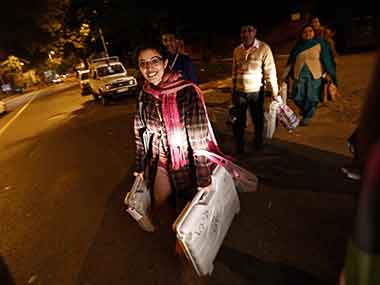Getting an equal probability electoral sample in India, particularly in an urban constituency with diverse demographics such as Delhi is difficult, still exit pollsters went ahead with their results; but their biggest technical flaw became evident too soon - about 100,000 people voted after they did their calculations. [caption id=“attachment_1268321” align=“alignleft” width=“380”]  Polling officers carry EVMs as they leave a polling station. Reuters[/caption] These 100,000 Delhiites are not just routine voters, but those who patiently waited for a few hours - some as long as four hours - to express their wish. That they waited this long and that this was an unprecedented phenomenon since the first Delhi assembly elections in 1993 makes the exit polls, which didn’t include, them null and void. The poll results may turn out to be the same as they predicted, but it will be purely by chance because this phenomenon would certainly skew the sampling. On an average, each constituency would have had more than 10,000 people who would have surged towards the evening and voted beyond the regular time of closure. For assembly elections, even a couple of thousands of votes make a huge difference. Who will this surge and resolve of the ’twilight’ voters help? Discussing this phenomenon on prime time TV, senior journalists who have seen many elections, were unanimous that this was unprecedented and hence indicated an unprecedented situation. The only unprecedented situation in Delhi is the debut of Aam Admi Party (AAP) and hence the late-evening affirmation will be certainly for them. In fact, three of them - Arati Jerat, Sankarshan Thakur and Vinod Mehta - were willing to stick their neck out and say that this phenomenon was certainly for them. Arati even said that it would be a sweep by the debutant. Any past examples? Last assembly elections in West Bengal when Trinamool Congress routed the Marxists. The commentators certainly have a valid point because the samples of the exit polls completely missed this demography. Who are these people? Going by the past, it’s safe to assume that this remarkable enthusiasm and willingness to wait may not have been for the Congress because in 1998, when the Congress beat the BJP, the polling was less than 50 percent, and in 2008, it was less than 58 percent. The same electorate is unlikely to surge to 66 percent five years later, when there is a huge anti-incumbency wave against the Congress, particularly with the lacklustre shows by Rahul Gandhi. So, if the surge is not for Congress, it could be against it or for the other parties, viz. the BJP and the AAP. BJP can indeed feel optimistic because in the first ever Delhi polls in 1993, the voting was high (close to 62 percent) and they won; but then there was nobody else in the fray, let alone a phenomenon such as the AAP and precedents such as the Ramlila spring, and the outrage against the gangrape. This is what makes the argument of an unprecedented situation valid. The only unprecedented situation in Delhi this time is the AAP and not the BJP, because the latter has been there right from the beginning. No other party in Indian history has made such an impact like this new generation outfit did - converting the urban middle class anger against corruption and misgovernance - when it was about to wane in the wake of an unsustainable Gandhian drama - into a political party of reckoning in nine months is certainly unprecedented. The Congress and the BJP were totally dismissive, the former - thanks to the likes of Kapil Sibal - being foolishly brutal. But when the pollsters started crunching their numbers, the party was certainly blipping on their radar. These are the undercurrents that conventional politicians and politics miss because they are so used to their old ways. Anti establishment anger doesn’t necessarily need to be consistently visible, particularly in urban areas because the middle class express it among themselves and do not come to the streets often. Their usual response to pitiful situations is apathy, but this time, they have a new party that spoke their language and mostly led by example. A party that converted the organisational skills of civil society movements into generating a political expression. Arvind Kejriwal, a civil society veteran, demonstrated that piloting a political movement and scaling up doesn’t need to follow the conventional models. And Delhi, with an urban, middle class and young electorate, was ready for innovation. So, the exit polls can all go wrong unless they appropriately correct the flaw by including the twilight sample. Perhaps what can tell the new story is a separate poll with samples from the evening voters alone. That will clearly tell us if it was an unprecedented situation and justifiably, an unprecedented response. But has anybody collected the samples of those who waited in the dark and the cold? Unlikely, because the pollsters were rushing to TV studios with their results without realising that the picture was still emerging.
Anti establishment anger doesn’t necessarily need to be consistently visible, particularly in urban areas because the middle class express it among themselves and do not come to the streets often.
Advertisement
End of Article


)
)
)
)
)
)
)
)
)



